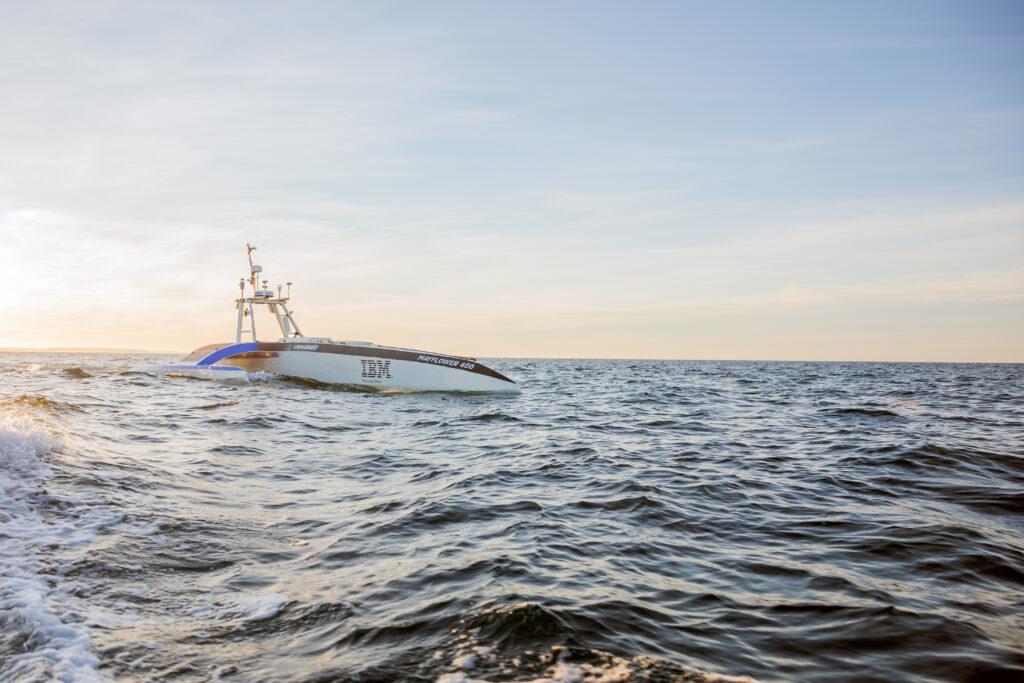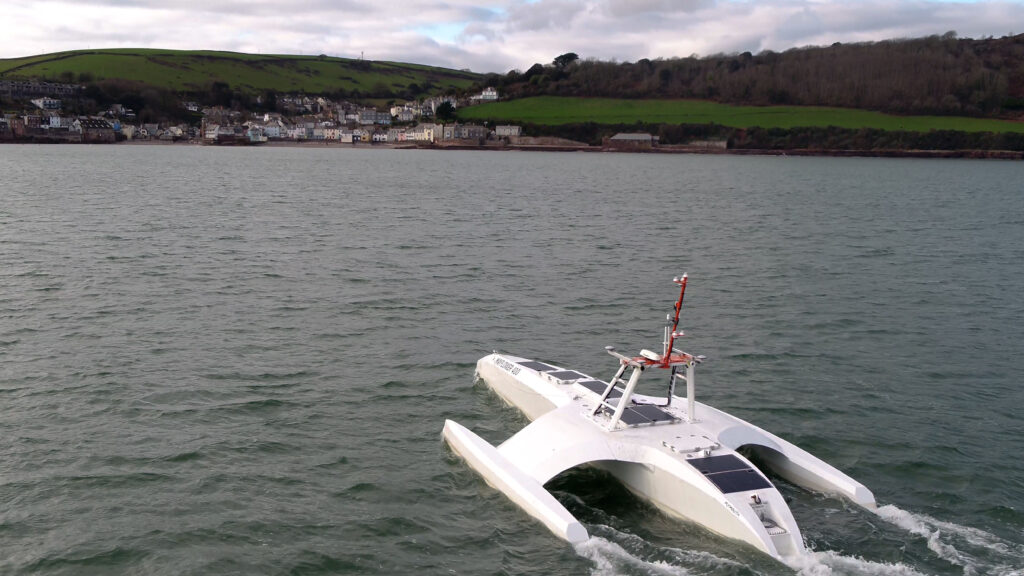
Roughly a year after a mechanical problem forced it to turn around, the Mayflower Autonomous Ship is poised to cross the Atlantic, traveling autonomously from Plymouth, United Kingdom, to Plymouth, Massachusetts.
The voyage will showcase IBM’s AI Captain, the artificial brain of the operation that allows Mayflower to chart its own course across the ocean and see and avoid obstacles along the way. That’s what sets Mayflower apart from other unmanned surface vessels, says Ray Spicer, vice president for defense and intelligence at IBM Federal.
“I think the key difference is the autonomous part,” he told Seapower in an interview. “In a perfect world, we’re gonna set this baby on its way from Plymouth, U.K., and not have to interfere at all. We’ll just watch it with pride as it sails along and makes its own decisions based on how well we trained it. And then it appears in Plymouth, Massachusetts, at the end of the journey.”
The project is led by marine research nonprofit ProMare, with IBM as lead technology and scientific partner.
The boat, a catamaran, originally set out on the voyage last spring but was forced to turn around when a connector for the onboard generator failed, filling the interior with exhaust fumes. No one was hurt — there’s no human aboard — but the boat was slowed significantly so the team decided to turn it around.
The brains of the boat, the AI Captain, worked fine and continues to do so, Spicer said. The system was trained using millions of images to recognize potential hazards, from seagulls to paddleboarders to buoys.
“We taught it to recognize objects, and the more experience it gets doing that, the better the training,” Spicer said. “When we put it out there, if it ran into something that it didn’t recognize, then we taught it, OK, that’s a seagull … make sure you recognize that in going forward. I would say anytime that it encounters something that we didn’t anticipate, we can see it from the camera, and we can teach the system what it is actually looking at.”

AI and COLREGS
Once underway, Mayflower will rely on its artificial intelligence and sensors to abide by COLREGS, the laws that govern ship movement on the seas.
Human operators have to be updated on COLREGS after switching from shore assignments to sea assignments to make sure they’re current, but that’s an easier process with an AI system.
Sailors and other human operators “always had to go through COLREGS, pass the test, make sure you were current, you were refreshed. With an AI/ML [artificial intelligence/machine learning] system like this, you just feed it the COLREGs one time, it chews them up and it won’t forget,” Spicer said.
The 3,200-mile trip from Plymouth to Plymouth is expected to take 10 to 12 days, depending on weather and other conditions that might pop up.
Mayflower carries visual sensors, infrared, cameras and a navigation system that allows it to use dead reckoning if it loses satellite connection.
“It’s also mapping the environment as it goes, because really the primary purpose of the vessel is to do oceanographic research,” Spicer said. “So, it’s listening to underwater sounds and it’s taking temperatures and [measuring] salinity and all kinds of things in the environment,” including measuring the amount of microplastics in the ocean.
Once it arrives on the East Coast of the United States, Mayflower is expected to take a victory lap that could take it from Norfolk, Virginia, to Washington, D.C., to Boston.
Flexible AI
The Mayflower’s brains are descended from IBM’s pioneering work in artificial intelligence and machine learning, including the Deep Blue chess computer that beat Garry Kasparov to Watson, the AI system that won on “Jeopardy!” in 2011.
“The interesting part to me is we took technologies that were already existing within IBM, and we just adapted them to this vessel,” Spicer said, including an operational decision manager used in the financial industry to verify credit card transactions.
“You swipe your credit card, and it runs hundreds of algorithms to make sure you’re you, and you’re not a bad guy, and then it lets the transaction go through. We use that same technology, we just adapted it to this use case,” Spicer said.
The ship’s systems generate a data tree, so researchers can see why it made a given decision at any point along its route.
Ultimately, the AI Captain could be used for much more than just piloting a small boat across an ocean.
In a video series about the Mayflower project, Brett Phaneuf, managing director of the program, said he envisions it one day guiding spacecraft on other worlds.
“Years from now I’d love to see our AI Captain on another vessel in an ocean on Europa or orbiting another planet. That would be ideal, and I don’t know if I’ll live to see it, but this is the start.”
Spicer agrees, saying, “I think the sky’s the limit. I mean, we’re talking about an application of a surface vessel, but think about underwater, think about in the air, think about space. We’ve gotten lots of interest from organizations like NASA and NOAA [the National Oceanic and Atmospheric Administration] … this [the Mayflower] is just the tip of the iceberg, I think.”




